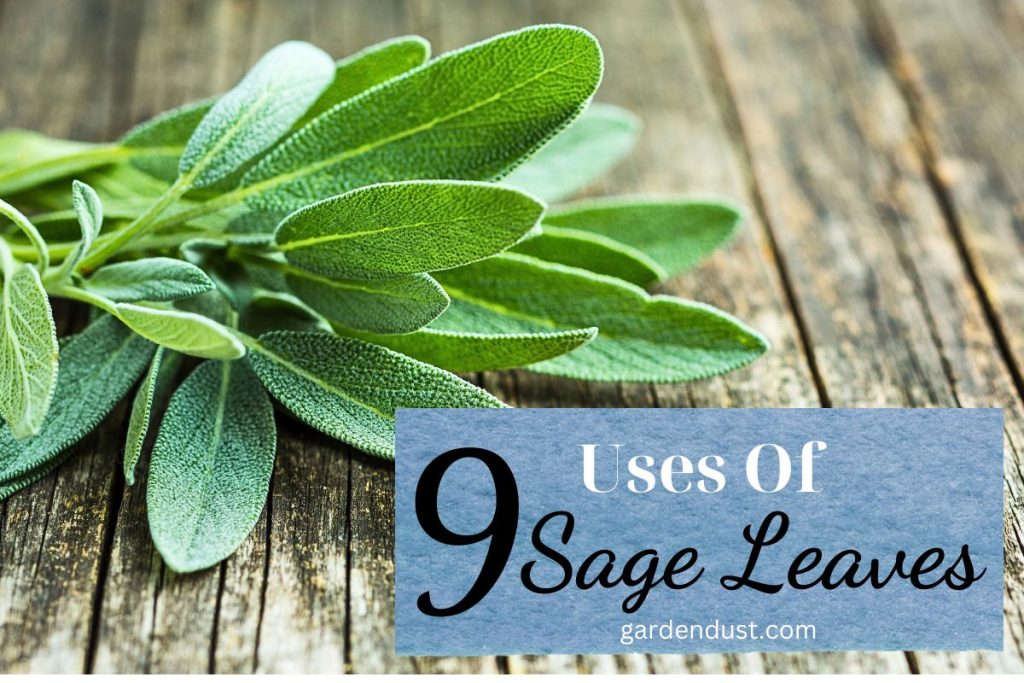Sage, with its scientific name Salvia officinalis, is a perennial herb renowned for its distinctive flavor and numerous health benefits. Beyond its culinary applications, sage leaves have been utilized for centuries for their medicinal properties and spiritual significance. In this article, we will explore 9 uses of sage leaves that go beyond the kitchen, showcasing the versatility and holistic benefits of this remarkable herb.
9 Uses Of Sage Leaves –
1. Culinary Delight
Sage’s most common use is undoubtedly in the kitchen, where its robust, earthy flavor enhances a variety of dishes. Whether used fresh or dried, sage leaves contribute a savory, slightly peppery taste to soups, stews, roasted meats, and pasta dishes. Sage butter, made by infusing butter with chopped sage leaves, is a delectable accompaniment to pasta or as a finishing touch for grilled vegetables. The herb’s versatility in the culinary world makes it an essential ingredient for any home chef.
2. Medicinal Marvel
Sage leaves have been valued for their medicinal properties since ancient times. Rich in antioxidants and anti-inflammatory compounds, sage is known to have antimicrobial properties. It has been traditionally used to alleviate sore throats, soothe digestive issues, and ease menopausal symptoms in women. Making sage tea by steeping fresh or dried sage leaves in hot water is a popular remedy for these ailments, providing a natural and holistic approach to health and well-being.
3. Aromatherapy and Essential Oils
The essential oil extracted from sage leaves is a treasure trove of aromatic compounds that can be harnessed for aromatherapy. Sage essential oil is celebrated for its ability to promote relaxation, reduce stress, and enhance mental clarity. Diffusing sage essential oil in your living space can create a calming atmosphere, aiding in meditation or simply creating a soothing environment after a long day. The aromatic qualities of sage have been harnessed for centuries for their potential to enhance mental and emotional well-being.
READ ALSO:-HOW TO GROW AND CARE FOR THYME PLANT
4. Natural Bug Repellent
Sage leaves possess natural insect-repelling properties, making them a valuable addition to your arsenal of natural bug deterrents. Placing sage leaves around your home or burning dried sage bundles, known as smudging, can help ward off mosquitoes and other unwanted pests. This eco-friendly alternative not only protects against insects but also fills your space with the pleasant, herbaceous scent of sage.
5. Culinary Garnish and Infused Vinegar
Beyond its role as a primary ingredient, sage leaves can be used as a visually appealing garnish to enhance the presentation of various dishes. The soft, velvety texture of sage leaves makes them an excellent choice for adding a touch of elegance to salads, soups, or main courses. Additionally, sage-infused vinegar is a delightful condiment that can be easily prepared by steeping fresh sage leaves in vinegar. The result is a tangy, herb-infused vinegar that adds depth of flavor to dressings and marinades.
6. Cleansing and Purification
Sage smudging is a centuries-old practice used for spiritual and energy cleansing. Burning dried sage bundles and wafting the smoke throughout a space is believed to clear negative energy and promote positive vibes. This ritual, rooted in various cultural traditions, is commonly employed in spiritual ceremonies, home blessings, and energy-clearing practices. The aromatic essence of burning sage is thought to purify both the physical and spiritual realms, creating a harmonious environment.
7. DIY Herbal Infusions
Sage leaves can be harnessed to create flavorful and aromatic herbal infusions, offering a delightful alternative to traditional teas. To make a sage infusion, steep fresh or dried sage leaves in hot water and let the herbaceous flavors unfold. This herbal beverage not only provides a pleasant taste but also carries the potential health benefits associated with sage, such as anti-inflammatory and antioxidant properties. Enjoying a cup of sage infusion can be a comforting and therapeutic ritual.
8. Culinary Preservation
Sage leaves can be employed for culinary preservation, adding their distinct flavor to various preserved foods. One popular method is to make sage-infused oil by steeping fresh sage leaves in olive oil. This infused oil can be used as a flavorful base for dressings, marinades, or simply as a drizzle over grilled vegetables. Additionally, sage leaves can be dried and used in pickling recipes, contributing a unique herbal note to preserved fruits and vegetables.
9. Enhancing Skincare
Sage leaves, with their antioxidant and anti-inflammatory properties, can be utilized to enhance skincare routines. Sage-infused oil or salves made from sage leaves can be applied topically to soothe irritated skin, reduce inflammation, and promote healing. The natural compounds in sage may contribute to maintaining healthy skin by fighting oxidative stress and supporting overall skin health. Including sage-infused skincare products in your routine can be a holistic approach to nourishing and rejuvenating your skin.
Sage leaves, with their myriad uses, transcend the boundaries of the kitchen to become a versatile herb enriching various aspects of our lives. From culinary delights to medicinal remedies, spiritual practices, and skincare routines, sage leaves offer a holistic approach to well-being. Embracing the diverse applications of sage allows us to unlock the full potential of this remarkable herb and incorporate its benefits into our daily lives. Whether in the form of a comforting cup of sage tea or the cleansing ritual of smudging, sage leaves continue to captivate our senses and contribute to a more balanced and harmonious lifestyle. Happy Gardening…







